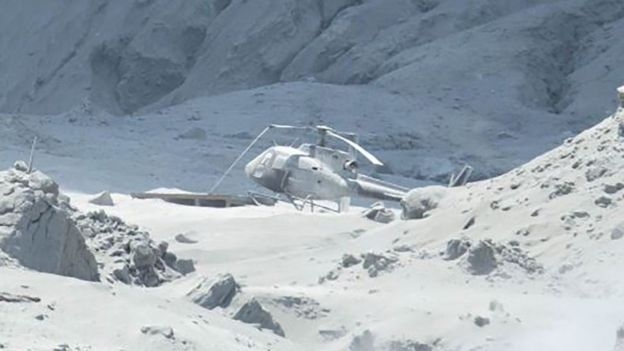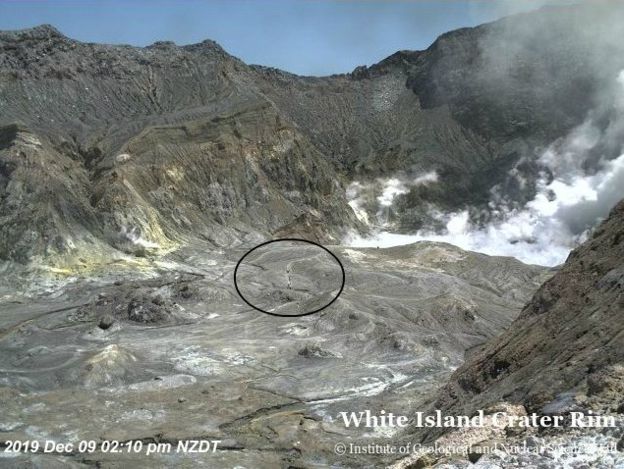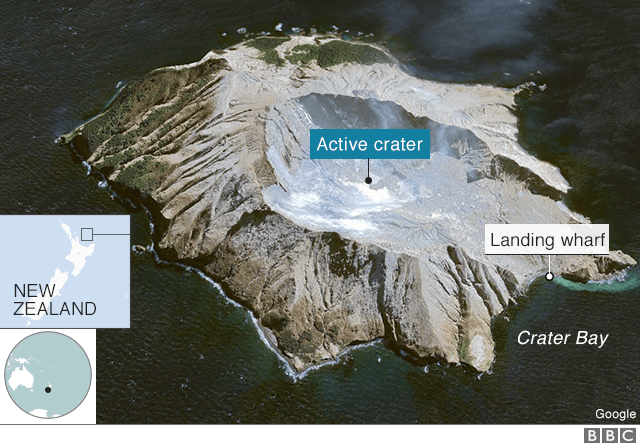New Zealand volcano: Rescuer tells of 'Chernobyl'-like scene
A paramedic who flew to New Zealand's White Island to rescue tourists after Monday's volcanic eruption has said the scene was like something out of "the Chernobyl mini-series".
"Everything was blanketed in ash," Russell Clark told TVNZ.
Dozens of tourists were on the island at the time. Six have been confirmed dead. Eight others are feared to have died and about 30 have serious burns.
New Zealand's PM Jacinda Ardern praised the crews of four rescue helicopters.
"Those pilots made an incredibly brave decision under extraordinarily dangerous circumstances in an attempt to get people out," she told reporters on Tuesday.
"To those who have lost or are missing family and friends, we share in your unfathomable grief and in your sorrow."
In his interview, Mr Clark said he and his fellow rescuers had found a "devastating scene" when they landed.
"There was a helicopter on the island that had obviously been there at the time and its rotor blades were off it."
At least 47 people from around the world were on the island at the time of the eruption.
Why were tourists allowed near the volcano?
Questions are being asked about why tourists were allowed to approach New Zealand's most active volcano three weeks after seismologists raised its alert level, describing the situation as "moderate to heightened volcanic unrest".
"These questions must be asked and they must be answered," Ms Ardern said in parliament on Tuesday. A police investigation is under way.
Geological hazard monitoring group GeoNet warned last week that White Island "may be entering a period where eruptive activity is more likely than normal" - but it also said "the current level of activity does not pose a direct hazard to visitors".
How serious are the injuries?
Thirty-four people were rescued, and most of them are still receiving treatment in hospital.
Officials say they have burns to more than 30% of their bodies. Several others are also suffering from inhalation burns. Doctors say some may not survive.
Police said they were "unsure" what state the bodies that remained on the island were in, saying they were probably "covered in ash".
White Island remains too dangerous to access, but reconnaissance flights conducted earlier on Tuesday saw no survivors.
Who was on the island?
There were 24 visitors from Australia, nine from the US, five from New Zealand, four from Germany, two from China, two from the UK, and one person from Malaysia.
The first victim to be identified was tour guide Hayden Marshall-Inman, a local of nearby town Whakatane, who according to New Zealand media has been named by his brother on Facebook.
The second person confirmed to have died is from Malaysia, the country's High Commission said.
Another tour guide from New Zealand, 23-year old Tipene Maangi, is among the missing. His family told media he had been called in on his day off.
Two British women were among those receiving treatment, said the UK High Commissioner to New Zealand, Laura Clarke.
Australian Prime Minister Scott Morrison said he "feared" three of the five confirmed dead were Australian.
Mr Morrison said that 24 Australians were on board a cruise ship exploring the island in the Bay of Plenty when the volcano erupted. Of those, 13 were in hospital and 11 were unaccounted for, he said.
"This is a terrible tragedy, a time of great innocence and joy interrupted by the horror of that eruption," Mr Morrison told reporters in Sydney.
What happened at the volcano?
White Island, also called Whakaari, is privately owned and a tourist destination with frequent day tours and scenic flights available.
The volcano erupted in two explosions in quick succession at around 14:11 (01:11 GMT) on Monday, sending up a thick plume of ash and vapour.
A live feed from the volcano showed several visitors inside the crater before the stream went dark.
Some survivors were rescued by boat in the immediate aftermath of the explosion, but police said it was too dangerous to mount a rescue operation.
But later private helicopter rescue missions picked up several people from the island.
Since then, emergency services have been unable to search the area because of dangerous conditions, with plumes of ash continuing to rise above the volcano.
Authorities on Tuesday said there was a 50% chance of a second eruption of the same size or smaller in the next 24 hours, but that it was unlikely there'd be a bigger eruption that would affect the mainland.
,
,
Related Posts



